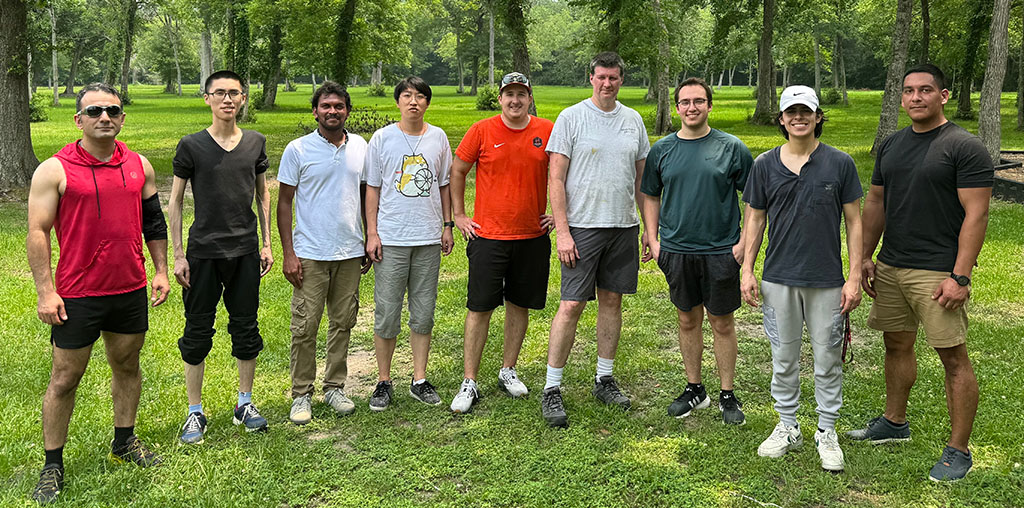
The National Science Foundation (NSF) has awarded $400,000 to Dr. Jeremy May, Professor of Chemistry at the University of Houston, to support his project, Electrophilic Deboronations in Synthesis. The grant will fund research that redefines how chemists build complex, carbon-based molecules, which serve as the essential structures behind pharmaceuticals, catalysts, and advanced materials.
May’s lab, known as The May Group, focuses on developing new reactions that eliminate the need for heavy metal catalysts. These reactions allow for faster, cleaner, and more sustainable synthesis of molecular frameworks that determine the shape and behavior of compounds.
“Every drug we take must be built molecule by molecule,” May said. “Our goal is to design and construct those molecular skeletons more efficiently without the heavy metals that complicate synthesis and purification.”

Turning a Problem into a Solution
For decades, chemists viewed “deborylation,” the loss of a boron atom from a carbon-boron bond, as an unwanted side reaction. The May Group saw an opportunity where others saw limitations. By reimagining this reaction as a productive step, May and his team developed a way to replace the boron atom with a new carbon-carbon bond, which forms the foundation of organic molecules.
“If something is going to happen anyway, why not make it work for us?” May said. “We learned to control this reaction and turn it into a constructive process, forming the core skeletons of molecules used in drug and materials design.”
This approach not only accelerates reaction times but also reduces chemical waste and avoids contamination risks associated with heavy metals—a critical advantage for pharmaceutical manufacturing.
Training the Next Generation of Synthetic Chemists
At the heart of May’s research is mentorship. His lab includes graduate and undergraduate students who learn the art and science of molecular construction, ranging from reaction design and mechanism studies to hands-on experimentation.
“Each year, students join the group knowing little about the process,” May said. “Within two years, they’re designing experiments, interpreting data, and telling me to let them work. Watching that transformation is incredibly rewarding.”
Since founding his lab in 2009, May has mentored more than 25 students, many of whom now hold positions at leading companies such as Chevron Phillips, Baker Hughes, Pfizer, and Oak Ridge National Laboratory. Several others have become faculty members or researchers across the globe, from Thailand to Saudi Arabia.
Exploring New Frontiers in Chemical Synthesis
The NSF-funded research will explore three major objectives over the next three years:
- Expanding Reaction Scope: Mapping the limits of new intermediates and testing their reactivity across diverse chemical systems.
- Catalyst Design: Creating molecular frameworks that mimic enzymes to precisely control metal-catalyzed reactions.
- Natural Product Synthesis: Replicating naturally occurring compounds with shared structural motifs found across plants, bacteria, and fungi to investigate their biological significance.
May believes these efforts could reveal new strategies for drug discovery, offering ways to modify existing medicines or design new ones that better target diseases.
Sustaining Discovery Through Support
Funding from the NSF not only drives scientific discovery but also supports the educational and research infrastructure of the University of Houston. May emphasized that grants like this one are vital for advancing both science and student training.
“These grants allow students to focus on research full time, gain experience with cutting-edge instrumentation, and contribute to discoveries that will shape the next generation of chemistry,” he said.
About Dr. Jeremy A. May
Jeremy May earned his Ph.D. from the California Institute of Technology and a B.S. (cum laude) from the University of Utah. He completed postdoctoral research at Memorial Sloan Kettering Cancer Center before joining UH in 2008. His research in synthetic organic chemistry and methods development aims to create efficient, sustainable approaches for building complex molecules with therapeutic and technological applications.
For more information, visit may.chem.uh.edu.